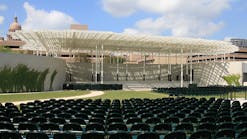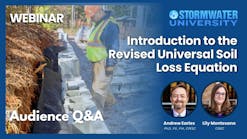In 1992, Joseph Vietri, then a coastal engineer with the U.S. Army Corps of Engineers (USACE) New York District, was walking with a colleague around Westhampton Beach, a barrier island located on the south shore of Long Island, N.Y.
“The island was recently beaten up by a Nor’easter. We were walking in ankle-deep water and started to wade into peat that must have broken off of a wetland,” Vietri says. “We looked at each other and said, ‘If something is not done immediately, this whole island is going to unravel within a week.’”
In a matter of days, this is exactly what happened. Water from the ocean side of the barrier island washed over and into the bay side, splitting the barrier island, creating a breach that quickly turned into a major inlet that swallowed up dozens of houses.
“We thought, we could never allow this to happen again. We can’t allow time to go by and not take collective action to fix this because at the end of the day it’s just going to cost us a lot of money, anguish, personal loss, and tragedy to the people in the area,” says Vietri, who is today the director of the Coastal Storm Risk Management National Center of Expertise, under the North Atlantic division of USACE.
The Army Corps realized that a more comprehensive long-term project to stabilize vulnerable shoreline was needed for the entire region, and the Fire Island Inlet to Montauk Point, New York, Coastal Storm Risk Management Project was born. The comprehensive project will manage the risks of coastal storm damage and sea level rise for barrier islands and back bay communities on Long Island’s south shore, while at the same time preserving natural resources.
The Project Area
Long Island extends out east into the Atlantic Ocean from New York City. Along the south shore of the island there are barrier island chains from Long Beach to Shinnecock Inlet.
In between Long Island’s mainland and the barrier islands is bay water that includes the Great South Bay, Moriches Bay, and Shinnecock Bay.
The project encompasses 83 miles of the south shore of the island — from Fire Island Inlet to Montauk Point — and extends inland two miles. The area covers the Suffolk County portion of the island that includes the towns of Babylon, Islip, Brookhaven, Southampton, and East Hampton, 12 incorporated villages, the Fire Island National Seashore, and the Poospatuck and Shinnecock Indian Reservations.
Over the years, the south shore of Long Island has become very populated and developed. Today, there are approximately 150,000 residents in the project area. Additionally, , there are 46,000 buildings that include 42,600 homes, 3,000 businesses, 60 schools, 2 hospitals, and 21 firehouses and police stations on Long Island.
To manage the risks of coastal storm damage and sea level rise, the Army Corps worked in collaboration with numerous agencies and communities, including the New York State Department of Environmental Conservation; New York State Department of State; Department of the Interior; National Park Service; U.S. Fish and Wildlife Service; U.S. Geological Service; Suffolk County Government; and the general public. These groups developed the project, which includes a breach response plan, home elevations, flood-proofing and acquisitions, coastal restoration, preservation of natural resources, and adaptations to sea level rise.
Breach Response Plan
Closing the breach will be accomplished by dredging sand from federal navigation channels and placing the sand on the barrier island to build the island back up.
Home Elevations, Flood Proofing, and Acquisitions
Homeowners will be able to decide if they want their homes elevated or floodproofed by the Army Corps. The homes will be elevated so that the lowest floor is above the flood level. Approximately 4,000 homes will be elevated.
Flood proofing is a technique used to reduce damages to homes that may be affected by floodwaters. Approximately 650 homes will be floodproofed using various methods, including the construction of ringwalls.
Coastal Restoration
To restore damaged coastal areas and provide protection to neighboring communities, about 4.2 million cubic yards of sand will be dredged from several federal channels; including Fire Island Inlet and shoals, and the Moriches and Shinnecock Inlets and shoals — enough sand to fill 420,000 dump trucks — and placed onto several beaches; including Gilgo Beach, Robert Moses State Park, and Tiana and Montauk Beaches. Depending on the project design, the sand can be placed to increase the height and width of a berm of the beach. It can also be used to create sand dunes. A sand replenished beach with dunes can prevent elevated ocean waters, caused by storms, from inundating coastal communities.
To help these beaches retain sand in one location, a feeder beach (a beach that has been stockpiled with extra sand) will be constructed along 6,000 feet of shorefront at Montauk Beach. This extra sand can naturally drift to other nearby beaches that may be losing sand.
To help facilitate the movement of this sand and restore the natural cross barrier island transport of sand in the region, two unneeded groins will be removed at Fire Island’s Ocean Beach Village.
Preserving Natural Resources
The project will not only reduce risks to the public but also restore coastal wetland habitats for endangered wildlife.
“As part of the coastal restoration aspect of the project, sand will be placed on 12 barrier islands,” Peter Weppler, chief of the USACE New York District’s Environmental Analysis Branch says. “The sand will be placed with native vegetation to create nesting and foraging habits for species such as Piping Plover, Least Turn, and various protected beach plant life.
In addition, this sand placement will also help to restore the natural cross barrier island transport of sand.”
Adapting to Sea Level Rise
“Based on our monitoring of sea level rise, this could mean increasing the volume of sand we place on beaches, increasing the height of berms and dunes over time to account for observed increases in sea level rise,” Weppler says.
Beginning Work
Work recently began on the project. The first phase includes dredging sand for placement on beaches.
The entire project is expected to be completed in a decade and all sand placement work will be replenished every few years, beyond the completion of the project.
Weppler, like Vietri, sees the 1992 Westhampton Beach breach as a pivotal time for the project. He remembers what the Army Corps did following the breach and says it was a sort of template for what would become the Fire Island Inlet to Montauk Point, New York, Coastal Storm Risk Management Project.
“This breach created a new inlet that quickly grew progressively wider to about a quarter mile,” he says. “Eighty houses were under water and many others heavily damaged. Some homes became isolated because the new inlet had cut through the only access road.”
Working with the community, the Army Corps repaired the breach, restored the beach and dune system, and created a habitat for endangered wildlife.
“This project will provide layers of protection against storm surge and sea level rise while maintaining and enhancing natural resources,” Vietri says. “It takes into account the oceanfront, back-bay communities, barrier islands, inlets, and estuaries in a way that is a collaborative effort. It is unique.” SW
Published in Stormwater magazine, May 2022.









